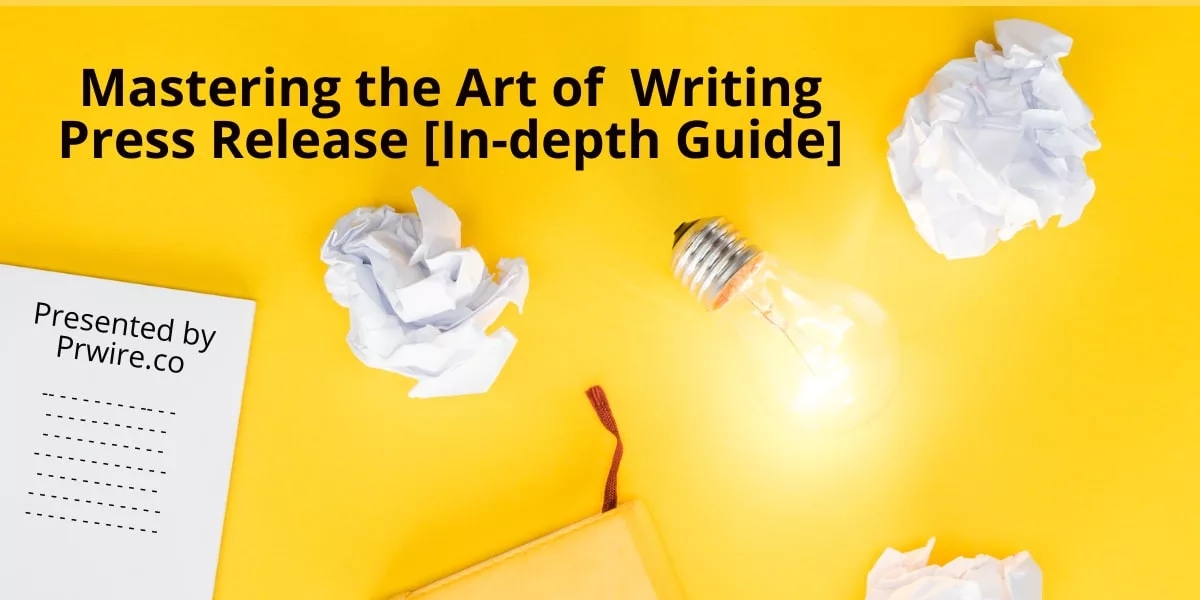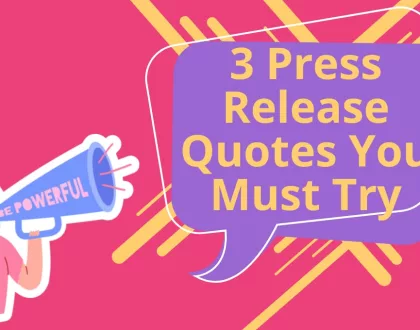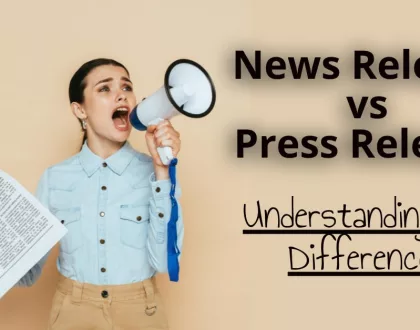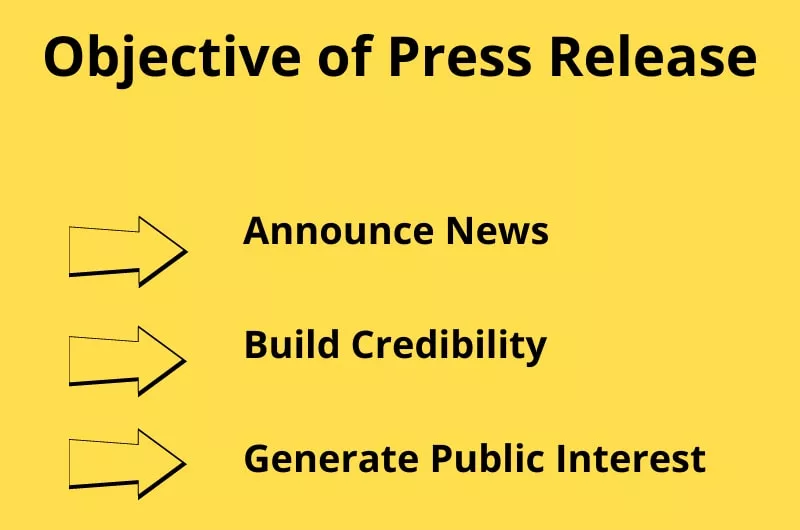How to Write a Press Release? – Tips From PR Experts

by Avneet Singh
In the digital age, where every company, organization, and startup vie for the world’s attention, the ability to tell your story effectively is paramount. Welcome to the world of “Mastering the Art of Writing Press Releases,” where words are not just a means of communication but the medium to visibility, credibility, and success.
In this blog post, we will delve deep into the fundamentals of crafting press releases that not only capture the essence of your message but also command the attention of journalists, influencers, and your target audience. Later we will also learn about optimizing press releases for distribution and how to measure the Impact along with some press release tips. Whether you’re an experienced PR professional looking to refine your skills or a newcomer seeking to make a mark in the competitive landscape of media outreach, this press release guide is your gateway to mastering how to write a good press release that truly shines.
Fundamentals of Press Releases
Understanding the fundamentals of press releases is essential for anyone looking to effectively communicate their news story to a broader audience. Let’s explore the basics of press releases, their objectives, and their role within your overall marketing strategy.
Defining a Press Release: What Is It Exactly?
A press release, often referred to as a news release or media release, is a written document designed to communicate newsworthy information to the media, industry insiders, and the general public. It serves as a bridge between organizations and the media, allowing companies, businesses, nonprofits, or individuals to share important announcements, developments, or events with the world.
A well-crafted press release provides readers with all the necessary information to understand the significance of your story and potentially feature it in their publications or broadcasts. In essence, it’s your opportunity to tell your story in a concise, informative, and engaging manner.
The Objectives and Goals of a Press Release
Announce News: The primary objective of a press release is to disseminate news. This could be anything from the launch of a new product or service to an important partnership, an upcoming event, financial results, or significant milestones within your organization.
Build Credibility: When your news is featured in reputable media outlets, it enhances your credibility and reputation. It’s seen as an endorsement from independent and trusted sources, which can help to establish your authority in your industry.
Generate Public Interest: Effective press releases captivate readers and generate public interest, motivating them to learn more about your news, product, or event.
How do Press Releases Fit into Your Overall Marketing Strategy?
Press releases are not standalone documents, they are integral components of your marketing and communication strategy. Here’s how they fit into the bigger picture:
Content Marketing: Press release content can be repurposed for various channels, extending its reach through blog posts, social media updates, or email newsletters.
Brand Building: Consistently issuing press releases reinforces your brand’s identity, showcasing your commitment to transparency and industry relevance.
Media Relations: Issuing newsworthy press releases nurtures relationships with journalists and media outlets, positioning you as a reliable news source.
Crisis Management: In times of crisis, press releases can be used to communicate your side of the story or provide updates to the public and the media. They help you maintain control of the narrative during challenging times.
SEO and Online Presence: Publishing press releases, with relevant keywords and website links, improve SEO efforts, making it easier for potential customers to find you online.
Crafting Compelling Press Releases
A well-crafted press release can elevate your message above the noise, capturing the attention of your target audience. In this section, we delve into the basics of how to write a good press release.
Identifying Newsworthy Topics
The foundation of any effective press release is a genuinely newsworthy topic. To stand out in the crowded media landscape, you must first identify what’s truly worth sharing. Here are some guidelines to help:
Timeliness: Is your topic current? News is called “news” for a reason; it’s about what’s happening now or what’s about to happen. Timely events, such as product launches, milestones, or events, are inherently newsworthy.
Relevance: Does your news matter to your target audience? Your press release should provide value or interest to your readers. Ensure that your topic aligns with their concerns, needs, or aspirations.
Impact: How significant is your news? A press release should highlight developments that have a meaningful impact on your organization, industry, or community. It could be a ground-breaking innovation, a significant event, or a charitable initiative that changes lives.
Uniqueness: Is your story one-of-a-kind? If your topic offers a fresh perspective, challenges conventions, or brings a unique angle to a common issue, it’s more likely to make headlines.
Choosing the Right Angle
Once you’ve identified a newsworthy topic, the next step is to choose the right angle—the perspective or focus that makes your press release compelling. Here are some angles to consider:
Human Interest: Highlight personal stories, challenges, or triumphs that resonate emotionally with your audience. People connect with stories about people.
Problem-Solution: Address a common problem or challenge and present your organization’s solution or innovation as a game-changer.
Trends and Insights: Share your insights or data analysis on industry trends, helping your audience better understand a complex issue.
Partnerships and Collaborations: Announce strategic partnerships, collaborations, or alliances that demonstrate your commitment to progress or shared values.
The Five W’s and One H
The backbone of a well-structured press release lies in answering the “Five W’s and One H”:
Who: Identify the key individuals or organizations involved in the news.
What: Clearly state the news or event you’re announcing.
Where: Specify the location of the event or news occurrence.
When: Provide the date and time of the event or when the news will take place.
Why: Explain why this news is significant or beneficial.
How: Describe how the news or event will unfold or how it will impact your audience.
How to Write Press Release? – Learn the Art of Writing an Effective Press Release
A well-written press release can serve as a powerful bridge between your organization’s news and the media’s attention, helping you capture the spotlight you deserve. In this article, we’ll learn how to write press release and will explore the key components of writing a press release that truly works.
Attention-Grabbing Headlines
The journey of your press release starts with its headline. It’s the first thing readers, including journalists and editors, see. A compelling headline grabs attention and entices the audience to read further. Here are some press release tips for creating an attention-grabbing headline:
Be Clear and Concise: Your headline should convey the main point of your press release concisely. Avoid jargon or overly complex language.
Highlight the Most Important Element: If there’s a single most significant aspect of your news, make sure it’s prominently featured in the headline.
Use Action Words: Verbs can add vigor to your headline. Consider using action words that convey a sense of motion or change.
Make it Unique: A unique angle or aspect of your news can make your headline stand out from the crowd. Think about what sets your story apart.
The Power of the Lead Paragraph
After the headline, the lead paragraph is your next chance to captivate your audience. It should expand upon the headline and provide a concise summary of the entire press release. Here’s how to make your lead paragraph impactful:
Get to the Point: Begin with the most critical information right away. Don’t bury the lead; state it upfront.
Answer the Five W’s and One H: Address the who, what, where, when, why, and how in your lead paragraph. This ensures that your audience gets the key details immediately.
Spark Interest: The lead paragraph should pique curiosity and compel readers to continue reading. It should convey why your news matters.
Crafting Engaging Body Content
The body of your press release provides the meat of your story. It should elaborate on the details presented in the headline and lead paragraph. Here’s how to craft engaging body content:
Organization: Arrange your content logically. Start with the most important information and follow with supporting details.
Be Objective: Maintain a neutral and factual tone throughout the body content. Avoid excessive promotional language.
Provide Context: Offer background information or context to help readers understand the significance of your news.
Incorporating Quotes
Quotes are an essential element of an effective press release. They provide a human touch to your story and allow key figures to express their views. Incorporating quotes from key figures within your organization or relevant experts can add depth and credibility to your press release. When incorporating quotes:
Choose Quotes Wisely: Select quotes that offer unique perspectives, emphasize the importance of the news, or provide expert insights.
Attribute Quotes Clearly: Clearly state who is speaking in the quote and their title or affiliation. This adds credibility to the statement.
Keep Quotes Concise: Quotes should be succinct and to the point. Avoid lengthy, convoluted statements.
Optimizing Press Releases for Distribution
Crafting a compelling press release is just the first step in the journey of getting your news noticed. However, It means nothing, if it is not distributed properly. To truly optimize press releases for distribution, you need to consider not only the content but also the format, SEO, and multimedia elements. We will now explore how to fine-tune your press releases for maximum impact and reach.
Press Release Format and Style
Clarity and Conciseness: A well-structured press release is easy to read and understand. Use clear and concise language to convey your message. Avoid jargon and overly complex sentences.
Inverted Pyramid Style: Follow the inverted pyramid structure, placing the most critical information at the beginning and gradually providing supporting details. This way, readers can grasp the essence of your news quickly.
AP Style: Adhere to the Associated Press Release (AP) style guidelines for consistency. Consistent formatting and style enhance readability and professionalism.
Headline and Subheadings: Craft a catchy headline that summarizes the main point of your press release. Use subheadings to break up content and make it easier for readers to scan.
Contact Information: Include contact information at the end of your press release. This allows journalists to reach out for additional information or interviews.
SEO for Press Releases
Keyword Research: Identify relevant keywords that journalists and readers might use to search for news related to your topic, and optimize your press release for search engine and users by adding those keywords naturally in the content. You can use tools like Google Keyword Planner for insights.
Incorporate Keywords: Naturally incorporate your chosen keywords into the press release content, including the headline, lead paragraph, and body. However, avoid keyword stuffing, which can harm readability.
Optimize Images: If your press release includes images, optimize them for SEO. Use descriptive file names and alt text that include keywords.
Hyperlinks: Include hyperlinks to your website and other relevant online resources. These not only provide additional context but also improve SEO.
Distribute on SEO-Friendly Platforms: Choose distribution platforms that are search engine optimized. Many PR distribution services optimize press releases for search engines, helping them rank higher in search results. Prwire.co is among very few newswire companies that can provide dofollow links from many top media sites.
Multimedia Integration
Incorporate high-quality images, infographics, or charts that complement your press release as visual content is more likely to capture readers’ attention. Additionally, consider embedding relevant videos to provide extra context or showcase product launches and events. It’s beneficial to include links to your organization’s social media profiles, encouraging readers to engage with your brand on various platforms. Lastly, if you have downloadable assets like PDFs, whitepapers, or reports related to your news, provide direct download links for accessibility and convenience.
The Press Release Distribution Process
Now at this time, you might have a well-written seo-optimised press release ready. The next step is to ensure it reaches its target audience and media sites. In this section, we’ll explore the key components of the press release distribution process, including targeting the right audience, utilizing online distribution platforms, and collaborating with press release distribution agencies.
Segment Your Audience: Break down your potential audience into segments based on demographics, interests, industry, and geography. This allows you to tailor your press release for each group.
Media Outlets: Identify media outlets, newspapers, magazines, blogs, and websites that regularly cover topics related to your news. Create a media list that includes contact information for relevant journalists and editors.
Industry Influencers: Reach out to industry influencers and thought leaders who have a significant following in your niche. They can help amplify your message to a broader audience.
Email Lists: If you have an email list of subscribers or interested parties, consider sending personalized press releases directly to them.
Social Media: Share your press release on social media platforms to reach your followers and encourage them to share it further.
How to Choose Best Press Release Distribution Agency?
Online distribution platforms have revolutionized the way press releases are disseminated. They offer a convenient and cost-effective way to reach a global audience. Press release distribution agencies specialize in getting your news in front of journalists and media outlets. They have established relationships and extensive networks that can help your press release gain traction. Here’s how to work effectively with them:
Research and Choose Wisely: Select a reputable distribution agency that has experience in your industry. Read reviews, ask for referrals, and review their distribution network.
Provide Clear Instructions: Communicate your goals, target audience, and key messages clearly to the agency. Be specific about your expectations and the desired outcomes.
Collaborative Effort: While the agency will handle distribution, consider collaborating on crafting the press release to ensure it aligns with your brand’s voice and goals. Prwire.co handles press release writing for free. It is included in all the packages without any extra cost.
Timing Matters: Consider the timing of your press release. Research shows that Tuesdays and Wednesdays are often the best days for distribution, while early morning or late afternoon is the ideal time.
Monitor and Analyze: Most online distribution platforms provide analytics to help you track the performance of your press release. Pay attention to metrics such as views, clicks, and social shares to assess its impact.
Check PR distribution Platforms: It is necessary to check on which press release distribution platform the agency will publish your PR. We at PRWire, publish press release on popular platforms like Yahoo , Bloomberg , Business Insider PR and AP press release
Measuring Press Release Impact
Understanding how to measure this impact is crucial for refining your communication strategies and achieving your PR goals. Let’s learn how to measure the impact of your press releases by analyzing metrics and the invaluable process of learning and adapting.
Analyzing Metrics
Web Traffic: One of the most immediate ways to gauge a press release’s impact is by tracking the increase in web traffic following its publication. Analytics tools can provide insights into how many visitors were driven to your website from the press release.
Click-Through Rates (CTR): CTR measures the effectiveness of your press release in encouraging readers to take action. It quantifies the percentage of people who clicked on links within your release, such as those leading to your website or additional resources.
Social Engagement: Social media shares, likes, comments, and retweets of your press release offer a tangible indicator of its impact. These metrics reflect the level of interest and engagement generated by your news.
Media Coverage: Monitor whether your press release was picked up by media outlets and how prominently it was featured. The more coverage you receive, especially from reputable sources, the more significant the impact.
Backlinks: Track the number of backlinks generated by your press release. These inbound links from other websites not only enhance your SEO but also signify that your news is considered valuable.
Conversion Rates: If your press release includes a call to action (CTA), such as signing up for a newsletter or making a purchase, assess the conversion rates. Calculate the percentage of readers who followed through with the desired action.
Sentiment Analysis: Analyze the sentiment surrounding your press release. Are the comments and feedback positive, negative, or neutral? This can provide valuable insights into the public perception of your news.
Learning and Adapting
Continuous Monitoring: Measure press release impact not just in the immediate aftermath of distribution but over time. Keep track of long-term trends and any spikes in engagement related to your news.
Feedback Loop: Engage with your audience. Encourage feedback and listen to their responses. Constructive criticism and suggestions can guide improvements in your press release strategy.
Adaptation: Flexibility is key. If certain metrics consistently show a lackluster impact, be willing to adjust your approach. This might involve changing the timing of your releases, refining your messaging, or targeting different audiences.
A/B Testing: Experiment with variations in your press releases. Test different headlines, content formats, or distribution channels to identify what resonates most with your audience. Compare the impact of different press releases. Identify common factors in high-impact releases and use this knowledge to improve future releases
Benchmarking: Compare your press release impact against industry benchmarks. Knowing how your performance measures up against competitors or peers can provide valuable context.
In this press release guide, we learned that mastering the art of writing press releases is not just about crafting words, it’s about strategically positioning your news to reach its intended audience. It is both an art and a science. Optimizing press releases for distribution is about how you present that content to your audience and make it discoverable. The press release distribution process is a multi-faceted endeavor that requires careful planning and execution. Last but not least, measuring the impact of your press releases is not only about tracking numbers but also about understanding the qualitative aspects of engagement and perception. Remember that press releases are not static, they are a dynamic tool for communication and storytelling, and their effectiveness can be honed over time.
Frequently Asked Questions (FAQs)
What Should I Include in the Boilerplate of a Press Release?
The boilerplate of a press release should include your company’s full name, a brief description of your core business, complete contact information (address, phone number, email, and website), and optionally, links to your social media profiles. The boilerplate paragraph, typically around 100-150 words, offers an overview of your company’s history, industry expertise, unique selling points, and notable achievements. It serves as a concise introduction for journalists and readers, allowing them to quickly understand your organization and how to get in touch for further inquiries or engagement.
How Many Quotes Should I Include in a Press Release?
The number of quotes in a press release can vary but typically ranges from one to two for shorter releases (around 400-500 words) and three to four for longer ones (600 words or more). Quotes should come from a variety of sources, such as company executives or experts, and be strategically placed for flow and reader engagement. Their primary role is to provide additional context, credibility, and a human element to the news, offering unique insights or perspectives that align with the press release’s messaging and objectives.
Can I Include Links in a Press Release for SEO Purposes?
Yes, you can include links in a press release for SEO purposes. Relevant and high-quality links can improve your website’s search engine ranking, drive organic traffic, and enhance the credibility of your press release. However, use links judiciously, ensuring they are relevant and add value to the reader’s understanding of the news.
Recommended Posts

How to Cite a Press Release? A Comprehensive Guide
April 12, 2024

3 Press Release Quotes You Must Try
March 20, 2024

News Release vs Press Release: Understanding the Differences
January 18, 2024





